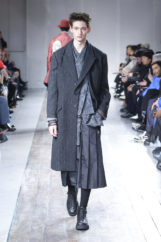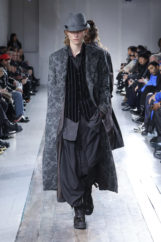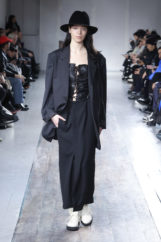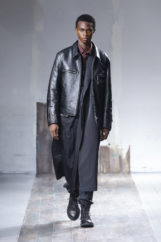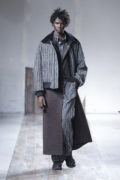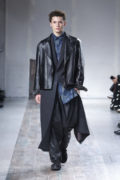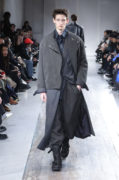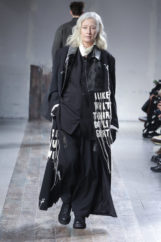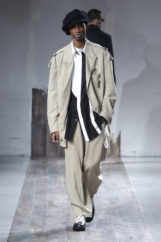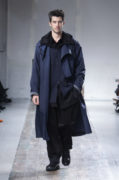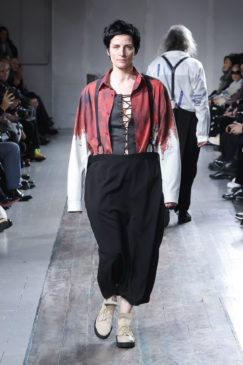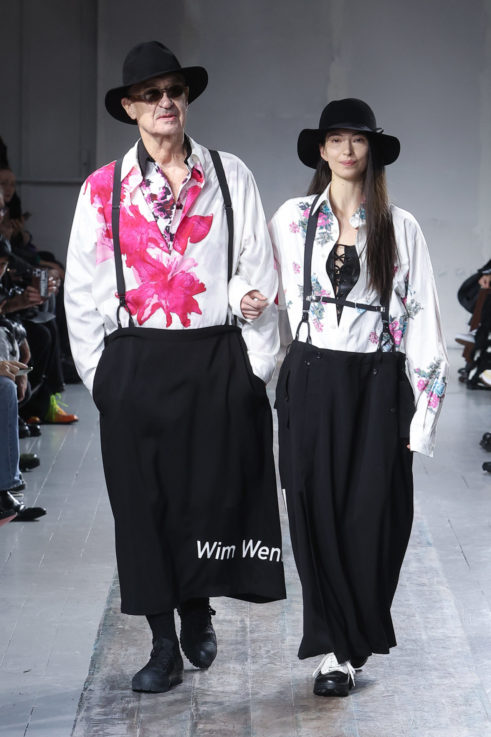Dear Shaded Viewers,
In the whirlwind of the fashion industry, where trends flicker and fade with unrelenting speed, Yohji Yamamoto’s Fall/Winter 2024 POUR HOMME collection emerges as a poignant paean to the art of slow living. At 80, Yamamoto doesn’t just design clothing; he composes symphonies of fabric and form, urging us to bask in the raw essence of human nature. This collection, an introspective journey anchored in tradition and memory, stands as a tribute to life’s unhurried moments.
Born in the shadows of WWII, Yamamoto’s narrative weaves through the “darkness” of the past, a motif elegantly captured in his latest offering. In a stroke of genius casting, an eclectic assembly of friends as models appeared. From the cinematic veteran Wim Wenders and Max Vadakul to the rugged charm of Norman Reedus and Warren Ellis, each model, irrespective of age or gender, parades down the runway, embodying the familial bonds that tie the collection together.
Yamamoto’s sartorial language is a blend of enigmatic statements and cryptic humor. Coats, jackets and pants bear phrases like, “YoYo loves black. Is your underwear black? Is it transparent?,” a playful nod to freedom of expression. The tailoring is quintessentially Yamamoto – oversized overcoats, blazers, and overall skirts that challenge conventional silhouettes.
The true revelation of the show lay in its auditory backdrop. Despite Yohji Yamamoto’s seasoned tenure, his musical selections evoked a youthful spirit. The runway resonated with hauntingly altered versions of familiar tunes: Radiohead’s “Creep,” Dua Lipa’s “Levitating,” and Taylor Swift’s “Lover,” each transformed into languorous, blues-inflected covers. Even more unexpected was the inclusion of “The Little Drummer Boy,” lending a mystifying, almost surreal edge to the atmosphere. This deliberate choice of soundtrack, blending the ethereal with the iconic, served to cast the spotlight firmly on the garments, while the melodies, reinterpreted either by a soulful female voice or Yamamoto himself, murmured a subtle yet poignant counterpoint in the background.
Yamamoto’s artistry transcends fashion; he is a renaissance man in a designer’s guise. The show progresses through eclectic narratives, each piece a chapter in a larger story. Poets’ blouses, velvet and brocade attire, embroidered coats, chevron wool blousons – each ensemble paints a portrait, a vivid tableau of Yamamoto’s artistic milieu.
The collection, while deeply personal, is also a canvas for Yamamoto’s long-standing collaborations. Figures like Wenders, Vadukul, and Ellis don not just clothes, but characters, echoing Yamamoto’s own persona.
The show’s denouement is a masterful interplay of names and narratives – Wenders in trousers bearing his own name, a nod to their shared history and resilience in transforming post-war darkness into poetic beauty.
Yamamoto’s collection is not just a fashion statement; it’s an existential contemplation. His designs, like his music choices, are reflections of a soul that has witnessed much but remains ever youthful in its quest for emotional depth and artistic integrity.
Yamamoto, with his inimitable black cap, is not just a designer; he’s a chronicler of times, an artisan of life’s fabrics. His Fall/Winter 2024 collection stands as a testament to his undying passion – a passion that resonates with both the old guard and the new from rapper Rich the Kid and Luka Sabbat front row on one side to Michele Lamy with our queen Diane Pernet on the other.
Later,
Leticia





